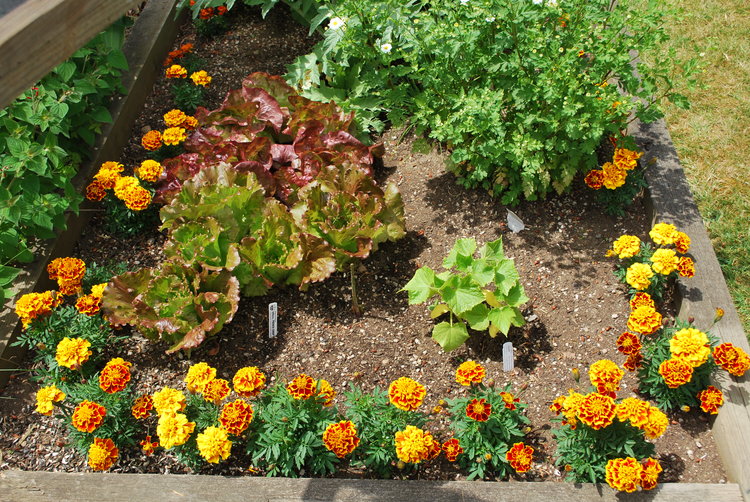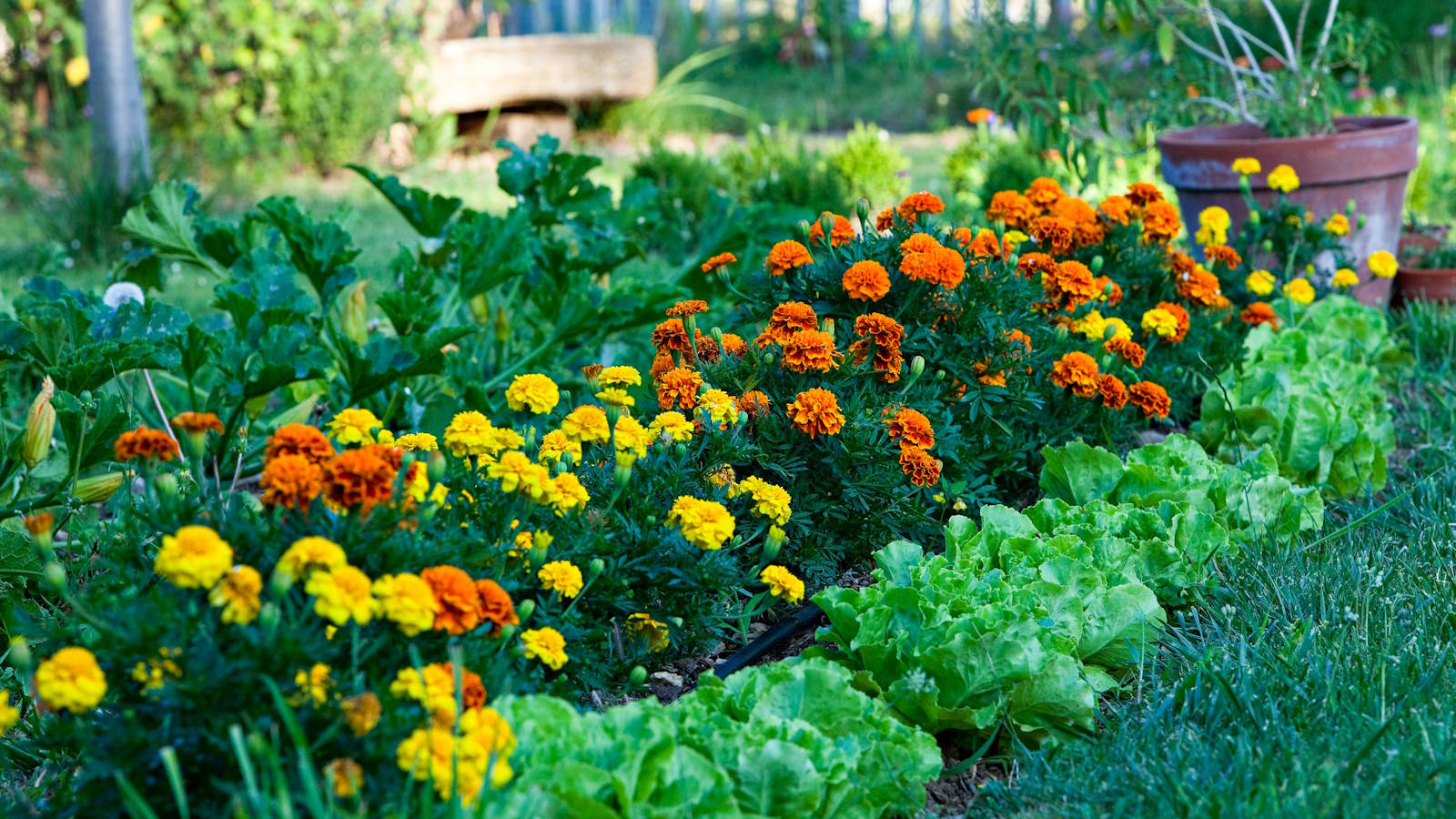Imagine stepping into your vegetable garden and being greeted by a vibrant splash of color from marigolds. Not only do these cheerful flowers brighten up your garden, but they also play a vital role in keeping your vegetables healthy.
If you’re a gardening enthusiast looking to maximize your harvest while minimizing pests, you’re in for a treat. Marigolds and vegetable gardens are a match made in horticultural heaven, and the benefits might just surprise you. Discover how these golden blooms can transform your gardening experience, making it more productive and visually stunning.
Get ready to uncover the secrets of this powerful combination and learn how to harness it for your garden’s success.

Credit: www.eachgreencorner.org
JUMP TO TOPIC
Benefits Of Marigolds In Gardens
Marigolds are not just beautiful flowers; they are garden superheroes. Many gardeners swear by marigolds for their unique ability to protect and enrich vegetable gardens. You might be surprised at how these vibrant blooms can transform your gardening experience, making it both enjoyable and fruitful. Let’s explore how marigolds offer remarkable benefits to your garden.
Natural Pest Control
Marigolds act as natural defenders against pesky insects. Their distinct scent can deter harmful bugs that love to feast on your vegetables. Have you ever noticed fewer aphids or nematodes when marigolds are around? It’s not magic—it’s nature at work. By planting marigolds alongside your veggies, you create a protective barrier that keeps unwanted guests at bay.
Imagine visiting your garden and finding healthy, untouched plants. Marigolds make this possible by warding off threats without the need for chemical pesticides. Isn’t it wonderful to rely on nature’s solutions?
Soil Health Improvement
Marigolds do more than just repel pests; they enhance soil health too. These flowers have roots that release chemicals into the soil. This natural process can reduce soil-borne diseases, offering a healthier environment for your vegetables.
Think about how vibrant your garden could be with enriched soil beneath it. Marigolds help in breaking down organic matter, making nutrients more accessible to your plants. Have you considered how much this simple addition could boost your garden’s productivity?
Moreover, marigolds can improve soil structure, allowing better water drainage and root growth. It’s fascinating how a small flower can play such a big role in ensuring your garden thrives.
- Repels aphids, nematodes, and other pests
- Improves soil structure and nutrient availability
- Reduces reliance on chemical pesticides and fertilizers
Are you ready to make marigolds a part of your gardening routine? Their benefits are not only practical but also cost-effective. Next time you plan your garden layout, remember to add marigolds and witness the transformation in your vegetable garden’s health and productivity.
Companion Planting With Marigolds
Companion planting involves growing plants together for mutual benefits. Marigolds are popular in this practice. These vibrant flowers don’t just add color. They also help protect vegetables from pests. Marigolds release a scent that repels harmful insects. This makes them perfect allies in the vegetable garden. Pairing marigolds with vegetables can improve growth and health.
Best Vegetables To Pair
Tomatoes thrive with marigolds. The flowers deter nematodes that harm tomato roots. Plant them around the base of tomato plants. Beans also benefit from marigolds. The flowers keep bean beetles away. Cabbage is another good match. Marigolds repel cabbage worms, keeping leaves safe.
Planting Strategies
Place marigolds between vegetable rows. This maximizes pest protection. Plant them in borders around the garden. This creates a barrier against unwanted insects. Space marigolds about 8 inches apart. This ensures good air circulation. Deadhead spent blooms to encourage more flowers. This keeps the marigolds blooming longer. Rotate marigolds to different spots each year. This prevents soil diseases from spreading.
Types Of Marigolds To Consider
Marigolds are a colorful addition to vegetable gardens. They deter pests and attract beneficial insects. Choosing the right type can enhance your garden’s health. Let’s explore some popular marigold varieties.
French Marigolds
French Marigolds are compact and bushy. They bloom in vibrant shades of orange and yellow. Their scent repels nematodes, protecting your vegetables. This variety grows well in containers and borders.
African Marigolds
African Marigolds are taller and have large blooms. Their bright flowers add a splash of color. These marigolds thrive in sunny spots. They also help with pest control in the garden.
Signet Marigolds
Signet Marigolds are small and delicate. Their leaves are edible and add flavor to salads. These marigolds attract pollinators with their lemon-scented flowers. They are ideal for edging and small spaces.
Planting And Care Tips
Marigolds are a wonderful addition to vegetable gardens. They add color and help deter pests. Proper planting and care ensure they thrive alongside your vegetables. This guide covers essential planting and care tips. Follow these to keep your marigolds healthy and vibrant.
Optimal Soil Conditions
Marigolds prefer well-drained soil. Ensure the soil is rich in organic matter. A pH level between 6.0 and 7.0 is ideal. Mix compost into the soil before planting. This improves soil fertility and structure. Avoid clay-heavy soils that retain too much water.
Watering And Sunlight Needs
Marigolds need full sunlight for healthy growth. They require at least six hours of direct sunlight daily. Water them regularly but avoid waterlogging. Allow the soil to dry between watering. Overwatering can lead to root rot. Use mulch to retain soil moisture and reduce weeds.
Seasonal Care Practices
Regularly remove dead flowers from marigolds. This encourages new blooms. In spring, fertilize lightly with a balanced fertilizer. Avoid heavy fertilization; it can reduce blooming. In cooler months, protect marigolds from frost. Cover them with a light cloth during cold nights. Rotate marigolds in your garden each year. This prevents soil depletion and pest buildup.
Common Pests And How Marigolds Help
Marigolds are popular in vegetable gardens, not just for their beauty. They act as natural pest repellents. Many pests can damage your vegetables. Marigolds can help keep them away. Their strong scent confuses and repels harmful insects. Let’s explore how marigolds help with common pests.
Nematodes
Nematodes are tiny worms that attack plant roots. They cause plants to wilt and die. Marigolds release chemicals into the soil. These chemicals kill or repel nematodes. Planting marigolds near vegetables can protect root systems. A healthier root means a healthier plant.
Aphids
Aphids are small insects that suck sap from plants. They weaken plants and spread diseases. Marigolds attract beneficial insects like ladybugs. Ladybugs eat aphids and control their population. This natural cycle helps maintain garden health.
Whiteflies
Whiteflies are pests that damage leaves by sucking their juices. They cause leaves to yellow and drop. Marigolds emit a scent that confuses whiteflies. This discourages them from settling on nearby plants. Keeping marigolds in your garden can help keep whiteflies away.
Harvesting And Utilizing Marigolds
Marigolds thrive as companions in vegetable gardens, deterring pests naturally. Their vibrant blooms also enrich garden soil. Harvesting these flowers provides benefits beyond beauty, including enhanced growth for nearby plants.
Harvesting and utilizing marigolds from your vegetable garden can be a rewarding experience that extends far beyond their vibrant blooms. These hardy flowers not only beautify your garden but also offer practical uses that many gardeners overlook. By collecting seeds and exploring culinary applications, you can maximize the benefits of marigolds, ensuring they play a key role in your garden and kitchen alike.Collecting Seeds
Collecting marigold seeds is a simple task that can save you money and ensure a bountiful garden next season. After the flowers dry and turn brown, gently pluck them from the plant. Pull the petals apart to reveal the seeds nestled inside, ready for next year’s planting. Store the seeds in a cool, dry place. Use paper envelopes or small jars for storage. Label them with the date and variety to keep your collection organized. Consider sharing seeds with friends or neighbors. This fosters community and keeps everyone’s gardens flourishing. Plus, swapping seeds can introduce you to new marigold varieties.Using Marigolds In Recipes
You might be surprised to learn that marigolds are edible! Their petals add a splash of color and a unique flavor to dishes. Try sprinkling them over salads for a citrusy zest. Infuse marigold petals in oils or vinegars to create flavorful dressings. This is an easy way to elevate your culinary creations with a homemade touch. Have you ever tried marigold tea? Steep the petals in hot water for a refreshing drink that some say aids digestion. Experiment with adding honey or lemon to tailor the taste to your liking. As you explore these uses, think about how marigolds can become a staple in your garden and kitchen. What other creative ways can you incorporate them into your daily life?Success Stories From Gardeners
Marigolds are more than just vibrant flowers. They play a crucial role in vegetable gardens. Many gardeners have shared their success stories. These stories highlight the benefits of planting marigolds alongside vegetables. Marigolds help deter pests and improve garden health. Let’s explore some real-life experiences from gardeners who have embraced this practice.
Case Studies
One gardener, Emma from Ohio, decided to plant marigolds around her tomato plants. She noticed a significant decrease in aphid infestations. Her tomatoes grew healthier and yielded more fruit. Emma now swears by marigolds in her garden.
Another success story comes from Raj in India. He planted marigolds alongside his beans. Raj observed fewer bean beetle attacks and healthier plants. His garden flourished, and he shared this tip with fellow gardeners.
Testimonials
Linda, a gardener from Florida, says, “Marigolds saved my garden from root-knot nematodes. My vegetables are thriving now.”
Carlos in Mexico shares his experience: “I planted marigolds with my peppers. The pest problem reduced drastically. I get more peppers now.”
These stories show the positive impact of marigolds in gardens. Gardeners from different regions have reaped the benefits. Their experiences inspire others to try marigolds with their vegetables.

Credit: www.botanicalinterests.com

Credit: learningasigotips.wordpress.com
Frequently Asked Questions
What Benefits Do Marigolds Bring To Vegetable Gardens?
Marigolds deter pests, enhance soil health, and attract beneficial insects. Their roots release compounds that repel harmful nematodes. They also attract pollinators like bees, which improve vegetable yield. Planting marigolds alongside vegetables can lead to healthier plants and a more productive garden.
How Do Marigolds Repel Garden Pests?
Marigolds emit a scent that deters common garden pests, including aphids and whiteflies. Their roots produce natural compounds that repel nematodes, protecting plant roots. By interplanting marigolds, you create a natural pest barrier. This reduces the need for chemical pesticides, promoting an eco-friendly garden environment.
Can Marigolds Enhance Vegetable Growth?
Yes, marigolds can enhance vegetable growth by attracting pollinators and beneficial insects. These insects help increase pollination and control harmful pests. Additionally, marigolds improve soil health by adding organic matter. This creates a favorable environment for vegetable plants to thrive, resulting in better growth and yields.
Do Marigolds Require Special Care In Gardens?
Marigolds are low-maintenance and thrive in most garden conditions. They prefer well-drained soil and full sunlight. Regular watering ensures healthy growth, but avoid overwatering. Deadheading spent flowers encourages continuous blooming. Their hardiness and minimal care requirements make them a gardener’s favorite for companion planting.
Conclusion
Marigolds bring joy and benefits to vegetable gardens. They deter pests naturally. Their bright blooms add beauty to your garden space. Plant them alongside vegetables for a healthier yield. These vibrant flowers are easy to grow and maintain. Even beginners can enjoy their charm.
Marigolds enrich the soil, supporting plant health. They are a smart choice for any gardener. Consider adding marigolds to your garden plan. Enjoy the vibrant colors and natural benefits. Your garden will thrive with their presence. Happy gardening!

